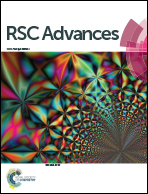Low temperature conversion of levulinic acid into γ-valerolactone using Zn to generate hydrogen from water and nickel catalysts supported on sepiolite†
Abstract
In the present article, γ-valerolactone has been obtained from levulinic acid with a yield exceeding 25% using very mild conditions without feeding hydrogen (30 °C, atmospheric pressure, water as the hydrogen source). The overall reaction conducted is a two-step process: first, a redox reaction involving the oxidation of metallic Zn to ZnO for in situ hydrogen production through the water splitting reaction and, second, a catalytic reaction involving Ni-supported catalysts for the production of γ-valerolactone from levulinic acid. Ni active sites have been supported on sepiolite, an abundant and cheap material. The nickel particle size has been demonstrated to be a parameter of paramount importance determining the catalytic activity, since the best catalytic performance is obtained with the smallest Ni nanoparticles. This combination of Zn and Ni supported on sepiolite shows a good catalytic stability after three catalytic runs.



 Please wait while we load your content...
Please wait while we load your content...